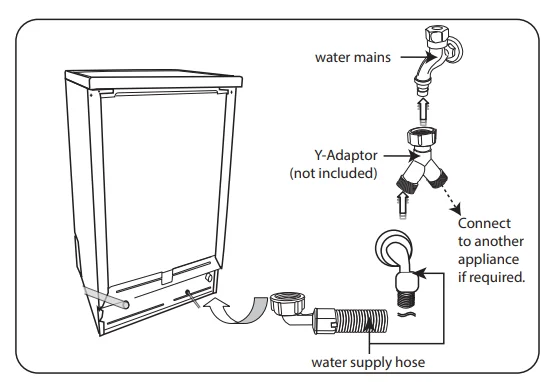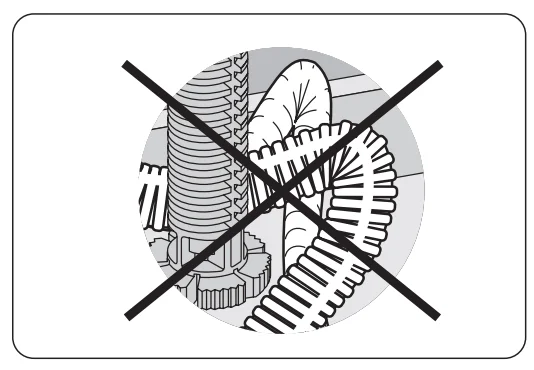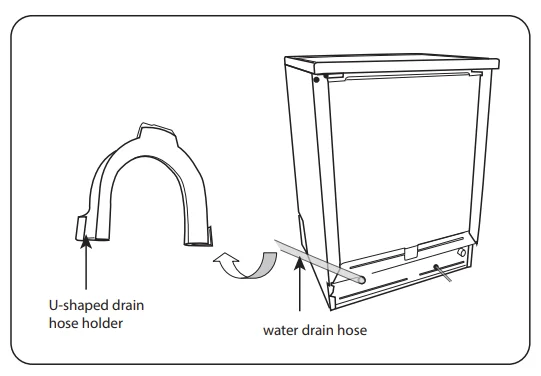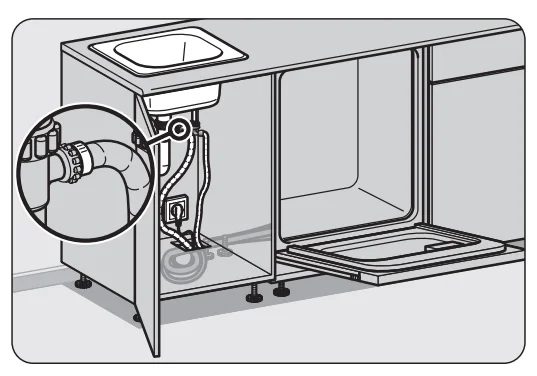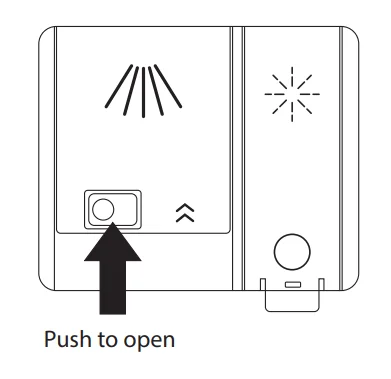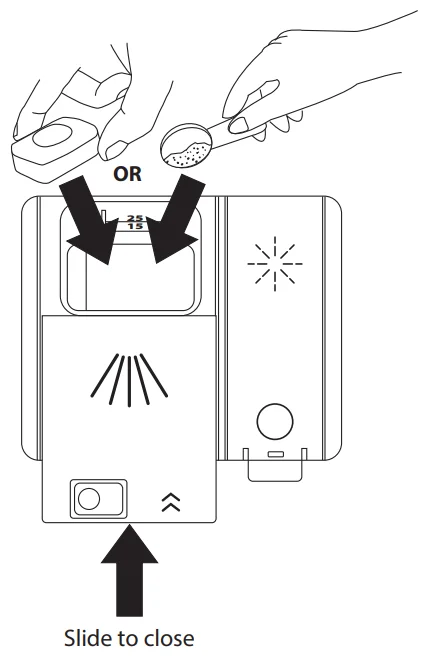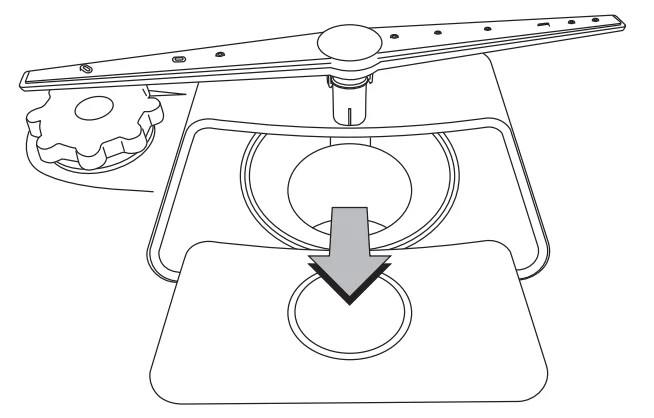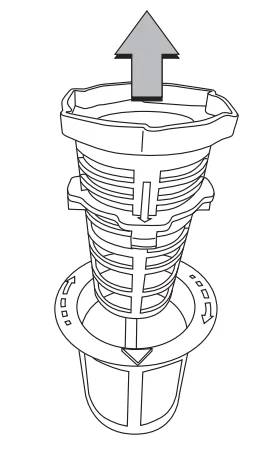
Currys ESSENTIALS CDW60W18 Full-Size Dishwasher

Safety Warnings
IMPORTANT SAFETY INSTRUCTIONS
READ CAREFULLY AND KEEP FOR FUTURE REFERENCE
- Read all instructions carefully before using the dishwasher and keep them for future reference.
- Retain the manual. If you pass the dishwasher onto a third party, make sure to include this manual.
- This appliance can be used by children aged 8 years and above and persons with reduced physical, sensory and mental capabilities, or lack of experience and knowledge, if they have been given supervision or instruction concerning he use of the appliance in a safe way and understand the hazards involved. Children shall not play with the appliance. Cleaning and user maintenance shall not be made by children without supervision.
- Keep ventilation openings in the dishwasher enclosure clear of obstructions.
- Choose a location for your dishwasher away from heat sources such as radiators or fires.
- Young children should be supervised to ensure that they do not play with the dishwasher.
- Keep the mains cable out of reach of children.
- Keep children away from detergents and rinse aids. These may cause chemical burns in the mouth, throat and eyes or asphyxiation.
- Keep children away from the dishwasher when the door is open.
- Switch off water and power and unplug before fitting or removing tools/attachments, after use and before cleaning.
- Keep your fingers away from moving parts and fitted attachments.
- Never use a damaged machine.
- If the mains cable is damaged, it must be replaced by the manufacturer, its service agent or a qualified technician in order to avoid a hazard.
- Keep the power unit, mains cable and plug away from water.
- Never exceed the maximum capacities.
- 2 people are required to lift this dishwasher.
- Only use the dishwasher for its intended domestic use.
- This appliance is for indoor domestic use only.
- Do not use with an extension lead or external timer.
Unpacking
Remove all packaging from the unit. Retain the packaging. If you dispose of it, please do so according to local regulations.
The following items are included:
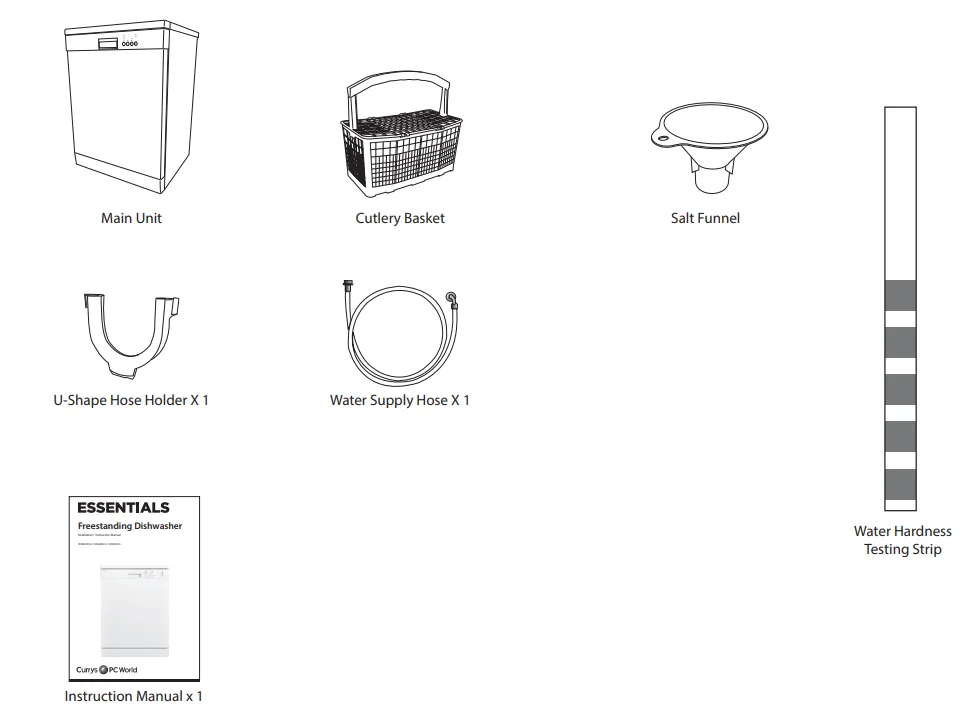
![]() This product has been wet tested to ensure correct operation. As a result, some water may remain inside the unit. This is normal and safe. Remove any water droplets from the exterior if necessary.
This product has been wet tested to ensure correct operation. As a result, some water may remain inside the unit. This is normal and safe. Remove any water droplets from the exterior if necessary.
If items are missing or damaged, please contact Partmaster (UK only).
Tel: 0344 800 3456 for assistance.
INSTALLATION
Location
When selecting a position for your freestanding dishwasher, you should make sure the installation surface is flat and firm, and the room is well ventilated. Avoid locating your dishwasher near a heat source, eg, cooker, boiler or radiator. Extreme cold ambient temperatures may also cause the appliance not to perform properly. This dishwasher is not designed for use in a garage or outdoor installation.
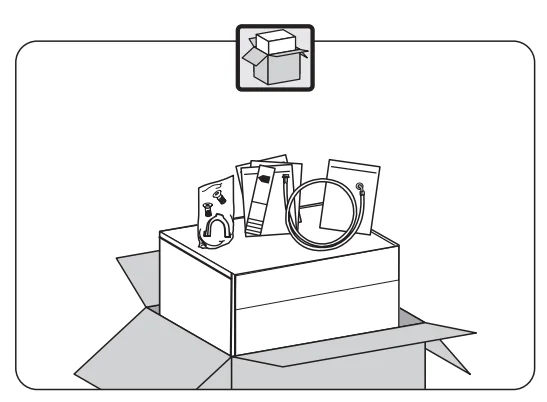
- Please ensure the dishwasher is installed by a qualified technician.
- Ensure there is sufficient clearance on each side of the unit to allow slight sideways movement for servicing when required. Good levelling is essential for the correct closure and sealing of the door. When the unit is correctly levelled, the door should not catch the inner liner on either side of the cabinet. The adjustable feet may be loosened or tightened in order to obtain the optimum levelling of the unit.

- Do not connect the unit to the mains socket before installation. Ensure you are not installing the unit right in front of the mains socket. This is to avoid potential damage to the back of the unit.

- Position the dishwasher next to a water tap and a drain. Ensure the water inlet and drain hoses are not kinked or squashed. The unit must not stand on the mains cable.

- Adjust the adjustable feet to obtain the optimum levelling of the unit. The adjustment of the rear feet is via a centre screw at the front.
 Making sure the dishwasher is level is very important. If it’s not level, the door may not seal properly, and it may leak.
Making sure the dishwasher is level is very important. If it’s not level, the door may not seal properly, and it may leak. - Make sure your plumbing is suitable for use with the dishwasher. If in doubt, contact a qualified plumber. This unit MUST BE connected to COLD WATER MAINS using the new water supply hose. OLD HOSE SETS MUST NOT BE RE-USED. The water pressure from the water mains needs to be at a minimum of 0.04 MPa and a maximum of 1.00MPa.

- Connect one end of the water supply hose to your dishwasher, and then connect the other end of the hose to your water mains. Please ensure the black rubber seal is in place.
- After connecting the hose, turn on your water mains and check for leaks.
- Connect the dishwasher to the mains socket.
Tip: You may use a Y-adaptor (not included) for an additional water feed for another appliance, for example, a washing machine. This is only applicable for cold water mains. A Y-adaptor is available from most DIY stores. - Do not bend or kink your drain hose.

- You may use the U-shaped drain hose holder to secure your drain hose and to avoid kinking it.

- Secure the water drain hose to the waste pipe to avoid it coming off during the washing process.


- The waste pipe must only be connected to the foul drains and not the surface water drainage system.
- The water drain hose should be placed between 40 cm and 100 cm from the floor level and must not be extended; otherwise, the unit may not be able to expel wastewater properly.

Product Overview
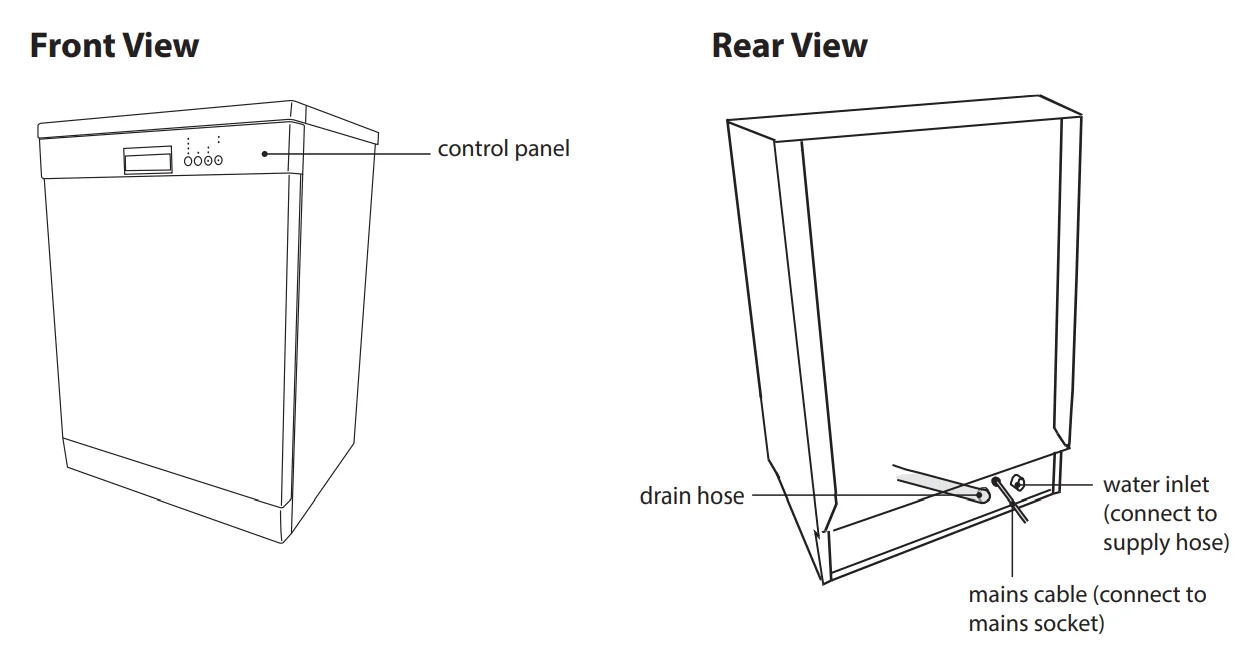
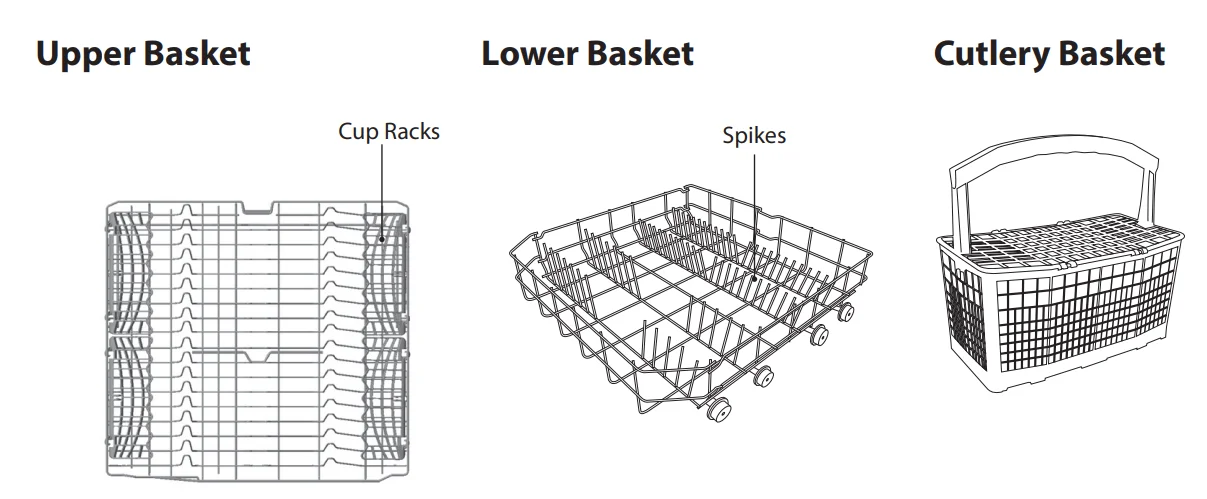
Internal View
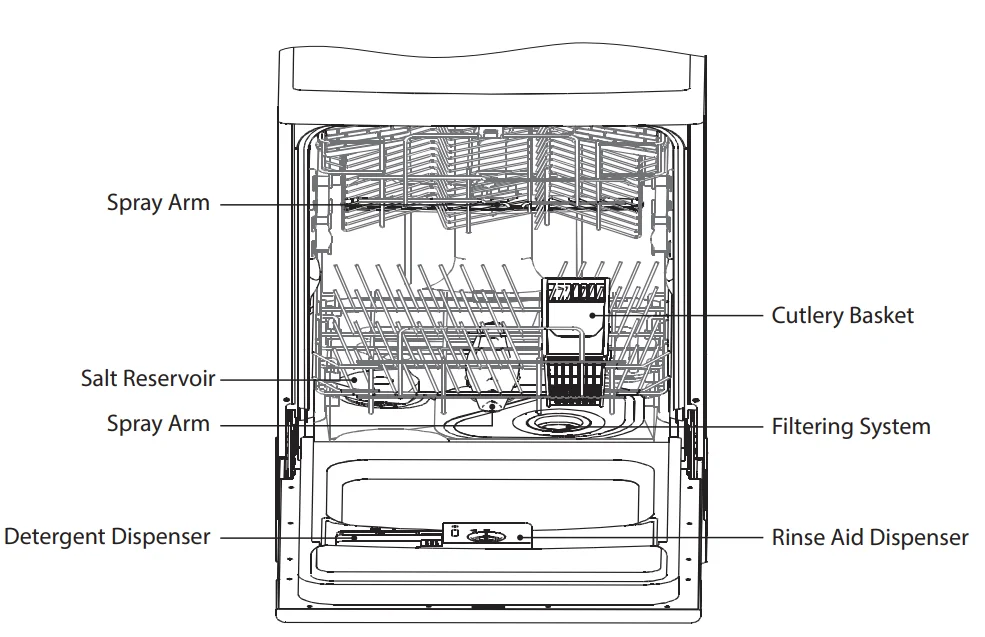
* All images are for indication only; please refer to your individual unit for the actual item.
Control Panel

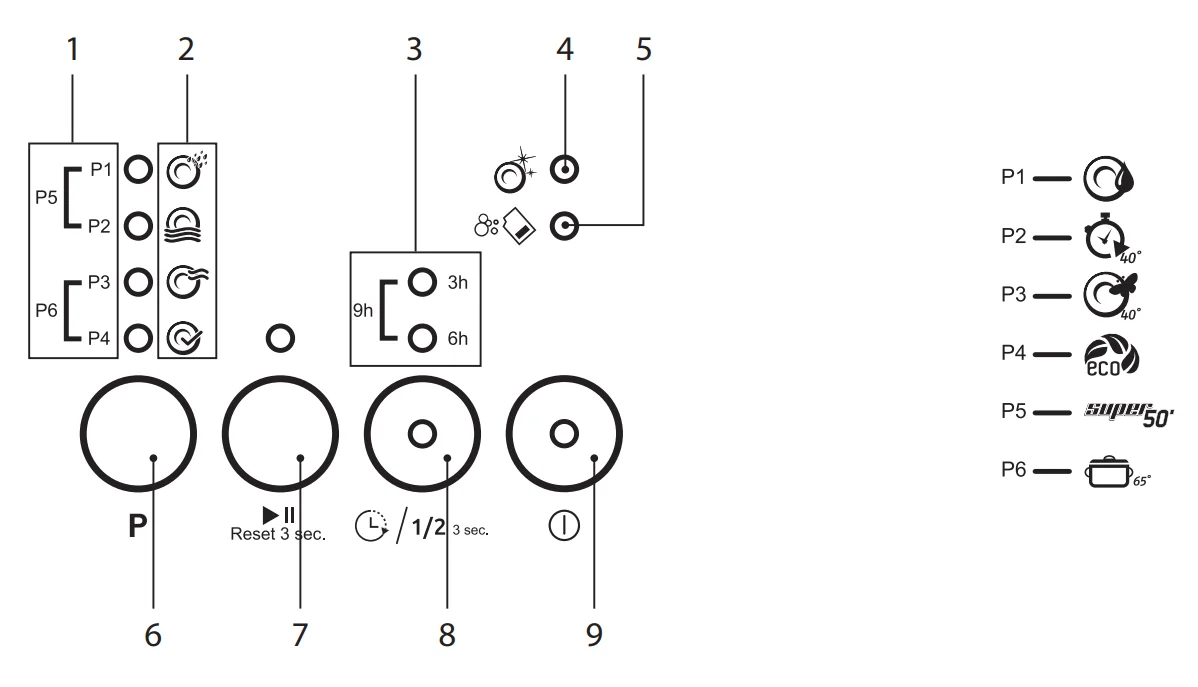
- Program Settings Indicator
- The LED indicates which program you are selecting when pressing the P button.
- Wash Cycle Status Indicator
- The LED indicates the progress of the wash cycle.
Filling – Heating & Washing – Rinsing – Drying/Finished.
- The LED indicates the progress of the wash cycle.
- Delay Timer Indicator
- Shows if a delay timer is set for 3, 6 or 9 hours.
- Rinse Aid Indicator
- Shows if rinse aid needs adding.
- Salt Indicator
- Shows if salt needs adding.
- Program Button
- Press to select one of the 6 wash programs.
- Start/Pause and Reset Button
- Press to start or pause the wash cycle.
- Press and hold for 3 seconds to reset the wash cycle.
- Timer Delay/ Half Load Button
- Press to select a timer delay of 3, 6 or 9 hours.
- Press and hold for 3 seconds to select half load.
- ON/OFF Button
- Press to turn the dishwasher power on and off.
- Door Handle
* All images are for indication only; please refer to your individual unit for the actual item.
Before Operating
To Open The Door
- Pull the door handle.
- If the door is opened during operation, open the door slightly to avoid water spillage.
Tip: If the door is opened during operation, all functions are automatically interrupted.
To Close The Door
- After loading the dishes, push the baskets fully into the dishwasher.
- Lift the door upwards and push until it clicks into position.
- Do not slam the dishwasher door.
Items Not Suitable for Use in the Dishwasher
When purchasing new crockery and cutlery, please make sure they are dishwasher-proof. Some items are not suitable for dishwashers.
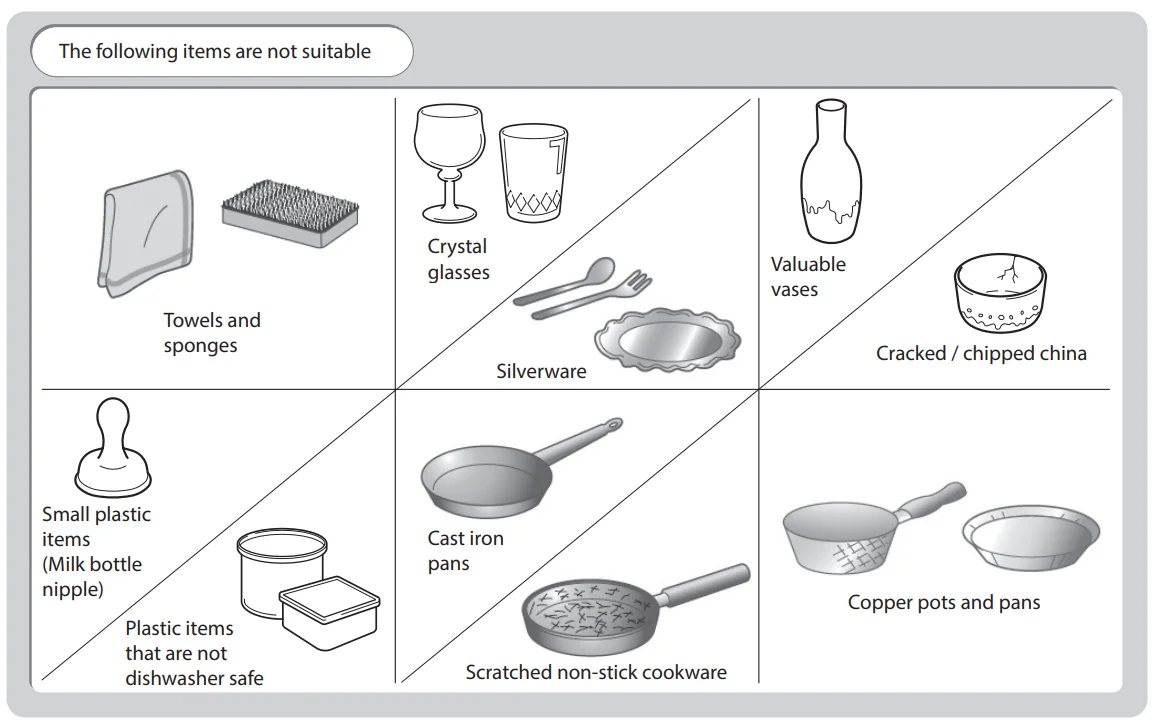
- Wooden cutlery and crockery or items with wooden parts may discolour and fade. The glue used in these items is not dishwasher-proof, and wooden handles may come loose after being washed in a dishwasher.
- Craft items, antiques, valuable vases and decorative glassware are also not suitable for dishwashers.
- Plastic items (e.gTupperwarere) which are not heat-resistant may melt or lose shape due to the high temperature in the dishwasher.
- Copper, brass, tin and aluminium items may discolour or become matt.
- Clouding may occur on glasses and delicate glassware after frequent washing. Do not wash delicate glassware or glassware containing lead crystal, a dishwasher. Wash delicate glassware by hand instead.
- Silver and aluminium parts have tended to discolour during washing. Residues like egg white, egg yolk and mustard often cause discolouring and staining on silver. Therefore, please clean the residues from the silver immediately after use.
* All images are for indication only; please refer to your individual unit for the actual item.
Adding Detergent Or Detergent Tablet
Only use detergents specifically designed for use in dishwashers. To be more environmentally friendly, please use no more than the correct amount of detergent. Fill the detergent dispenser with detergent powder or a tablet.
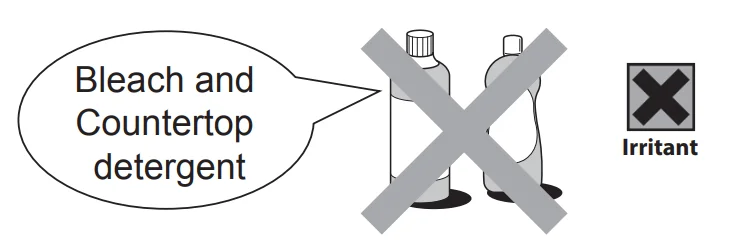
![]()
- Keep detergents and bleaches out of the reach of children.
- Irritating to the yes.
- Avoid contact with the eyes. In case of contact with the eyes, rinse immediately with plenty of water and seek medical advice.
- If swallowed, seek medical advice immediately.
Please follow the steps below to fill the detergent dispenser.
- Push the button on the lid of the detergent dispenser to open the flap with a slide open.

- Fill the detergent dispenser with detergent powder or insert the detergent tablet. The marking indicates the filling level.
- Slide the lid firmly so that it clicks into place.

* All images are for reference only; please refer to your individual unit for the actual item.
Adding Rinse Aid
Rinse aid helps to ensure water does not cling and leave marks on crockery during the drying phase, and helps crockery dry faster after it has been washed. Only pour rinse aid that is for domestic dishwashers into the reservoir. This model is designed to use liquid rinse aids only.
Please follow the steps below to pour the rinse aid into the storage reservoir. The amount will dispense automatically.
- Open the rinse aid compartment.
- Fill the compartment with rinse aid up to the MAX level mark. Be careful not to overfill the reservoir. Wipe up any spills.
- Close the rinse aid compartment.
- The rinse aid warning light will illuminate when the reservoir is running out of rinse aid and requires refilling.

![]()
If the water hardness in your area is soft, you may not need rinse aid, as it may cause white film to develop on your dishes.
Tip: If you decide to use a detergent tablet, you may not need to add rinse aid to the rinse aid reservoir.
Adjusting the Rinse Aid Reservoir
The rinse aid reservoir has five settings. Both the recommended setting and the factory setting are “4.” If the dishes are not drying properly or are spotted, adjust to the next higher number until your dishes are spot-free.
If they are spotted with rinse aid, when the cycle has finished the reduce the level.
- With the dishwasher switched off,ff press and hold the PROGRAM button. While holding the PROGRAM button down, press the ON/OFF button.
- Keep holding the PROGRAM button (approx 5 seconds) until all the lights flash twice. One or more of the Program Indicator lights will be on, which indicates which rinse aid level is currently set.
- Press the PROGRAM button to scroll through the levels, see the rinse aid table.
- When the desired level is selected, press the ON/OFF button. The level is now saved.
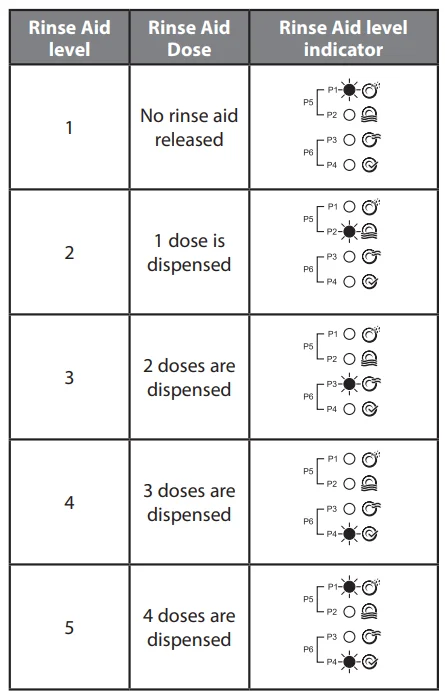
Testing your Water Hardness
The washing effectiveness of your machine depends on the softness of the tap water. For this reason, your machine is equipped with a system that reduces the hardness ithe n the mains water supply. The washing effectiveness will increase when the system is correctly set. To find out the water hardness level of water in your area, contact your local water board or determine the water hardness level by using the test strip (if available).
- Open the testing strip.
- Run your cold tap for a minute, then fill a cup/glass with water.
- Dip the testing strip into the water for 1 second.
- Shake off the excess water and wait 1 minute for the result.
Results Table
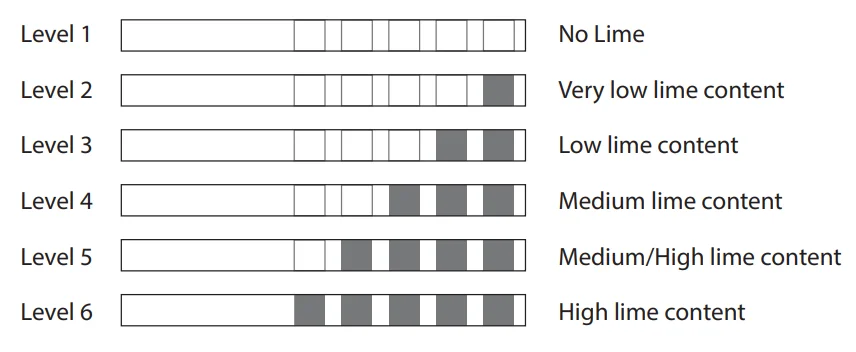
Now that you have your water hardness result, you can set your dishwasher’s salt consumption level to match.
Starting a Wash Cycle
- Ensure the unit is connected to the mains power and the water supply is on (water pressure between 0.03MPa and 1.00MPa).
- Open the door. Pull out the lower and upper baskets, load the dishes and push the baskets back. It is recommended that the lower basket be loaded first, and then the upper basket.
- Pour in the detergent or place the detergent tablet in the detergent compartment and close firmly afterwards.
- Close the dishwasher door. A click should be heard when the door is closed correctly. Do not slam the door.
- Press the ON/OFF button the LED will light on the button to show the dishwasher is switched on.
- Select the wash cycle programme based on the loading and soil requirements by pressing the PROGRAM button. Please refer to the section “Wash Cycle Table”.
- Press the START/PAUSE button, the LED will switch off and the LED next to the
 will light. The washing cycle will begin shortly.
will light. The washing cycle will begin shortly.
![]()
If you open the dishwasher door during the washing cycle and then close it, the dishwasher will continue the current washing programme once the door is closed.
Changing a Programme
To change the programme if the washing cycle has already started, follow the steps below.
- Open the door slightly to avoid water spillage before opening the door fully. Check if the unit has dispensed the detergent or detergent tablet. This will depend on how long the washing cycle was running for.
- If the detergent dispenser is opened, we suggest that you allow the wash cycle to finish.
- If the detergent dispenser is still closed, close the door, then press the START/PAUSE button. The programme will pause.
- Press the PROGRAM button to select a new programme.
- Press the START/PAUSE to start the new programme.
Cancelling a Programme
To cancel a programme and drain the dishwasher, follow the steps below.
Press and hold the START/PAUSE button for 3 seconds. The current programme will stop op and the dishwasher will drain. The ![]() LED will flash while the dishwasher is draining.
LED will flash while the dishwasher is draining.
At the End of a Programme
At the end of the programme, the end-of-cycle indicator ![]() will turn on.
will turn on.
![]()
It is advisable to leave the door closed until you are ready to unload the crockery. However, leaving the dishwasher door ajar will speed up the drying process.
Setting a Timer Delay
You can set a delay timer on your dishwasher; this will start the wash programme 3, 6 or 9 hours after setting the timer.
- After selecting your desired programme, press the
 DELAY TIMER button, press once for a 3-hour delay, twice for a 6-hour delay and three times for a 9-hour delay. If you continue pressing the button, the delay will switch off.
DELAY TIMER button, press once for a 3-hour delay, twice for a 6-hour delay and three times for a 9-hour delay. If you continue pressing the button, the delay will switch off. - Press the START/PAUSE button to start the program. The delay LED will flash once to indicate the programme has started, and in 3, 6 or 9 ho, urs dishwasher will start.
Selecting Half Load Mode
Your dishwasher’s self-load etting first, before you haven’t filled your dishwasher and you just want to wash a few items. The half load mode isn’t available on programmes 1 and 2. This will still wash the top and bottom baskets, it will reduce the programme time, and in some cases, it will reduce the water used.
- Select your desired program, then press and hold the
 /1/₂ button for 3 seconds. The LED will light on the button to show that tthatthe full loads are selected.
/1/₂ button for 3 seconds. The LED will light on the button to show that tthatthe full loads are selected. - Press START/PAUSE to start the programme.
Cancelling Half Load Mode
If you don’t cancel the half load mode, it will remain on next time you select a programme.
- Press and hold the
 /1/₂ button for 3 seconds. When the LED on the button switches off, the mode is off, or press the ON/OFF button.
/1/₂ button for 3 seconds. When the LED on the button switches off, the mode is off, or press the ON/OFF button.
Cleaning After Use
External Care
The Door and the Door Seal
- Clean the door seals regularly with a soft, damp cloth to remove food deposits.
- When the dishwasher is being loaded, food and drink residues may drip onto the sides of the dishwasher door. These surfaces are outside the wash cabinet and are not accessed by water from the spray arms. Any deposits should be wiped off before the door is closed.
The Control Panel
If cleaning is required, the control panel should be wiped with a soft, damp cloth ONLY.
![]()
- To avoid penetration of water into the door lock and electrical components, do not use a spray cleaner of any kind.
- Never use abrasive cleaners or scouring pads on the outer surfaces because they may scratch the finish. Some paper towels may also scratch or leave marks on the surface.
Internal Care
Filtering System
The filtering system at the base of the wash cabinet retains coarse debris from the washing cycle.
The collected coarse debris may cause the filters to clog. Check the condition of the filters regularly and clean them if necessary under running water.
Follow the steps below to clean the filters in the wash cabinet.
- Ensure the dishwasher is switched off.
- Turn the coarse filter anticlockwise and gently lift it out.

- Gently lift the main filter and the fine filter with care.

- Rinse all the filters under running water, including the filter cylinder, and then refit all filters in the reverse order.
- Gently refit the main filter back with care.
- Gently re-screw the coarse filter in a clockwise direction.

![]()
- Do not over-tighten the filters.
- Put the filters back in sequence securely; otherwise, coarse debris could get into the system and cause a blockage.
- NEVER use the dishwasher without the filters in place. Improper replacement of the filters may reduce the performance level of the appliance and damage dishes and utensils.
* Images are for reference only. Please refer to your individual model for details.
Spray Arms
Particles of food can get stuck in the spray arm jets and bearings. The spray arms should be checked and cleaned regularly.
- Ensure the dishwasher is switched off.
- Check whether or not the holes for the upper and lower spray arms are clogged. If there is any clogging, remove the spray arms and clean them under running water.

- You can remove the lower spray arm by pulling it upwards, while the upper spray arm nut can be removed by turning the nut to the left.
- Be sure that the nut is perfectly tightened when refitting the upper spray arm.
Technical Problems
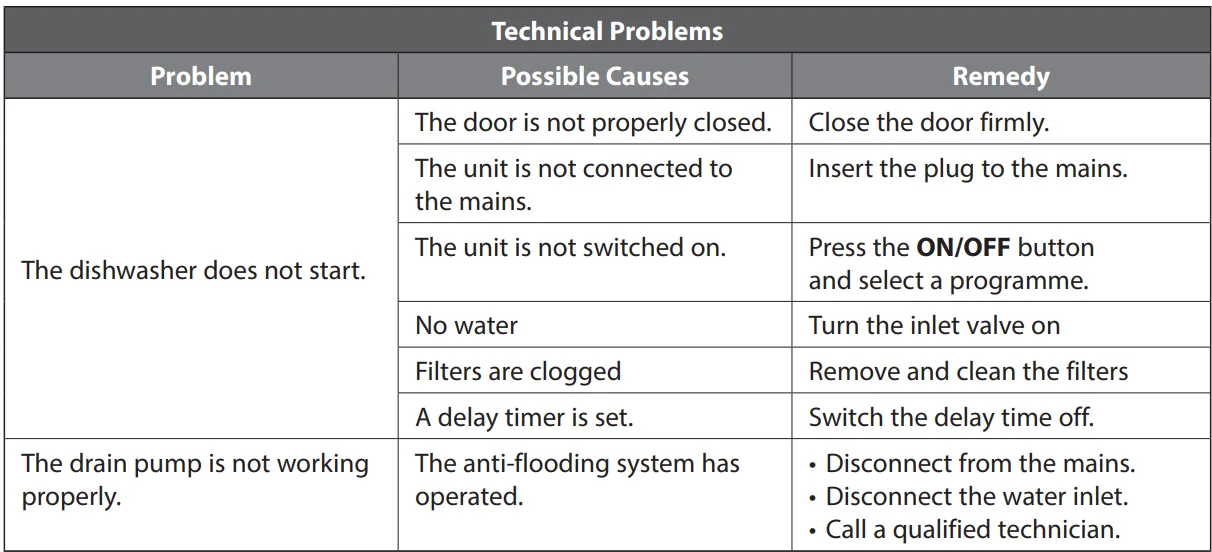
General Problems
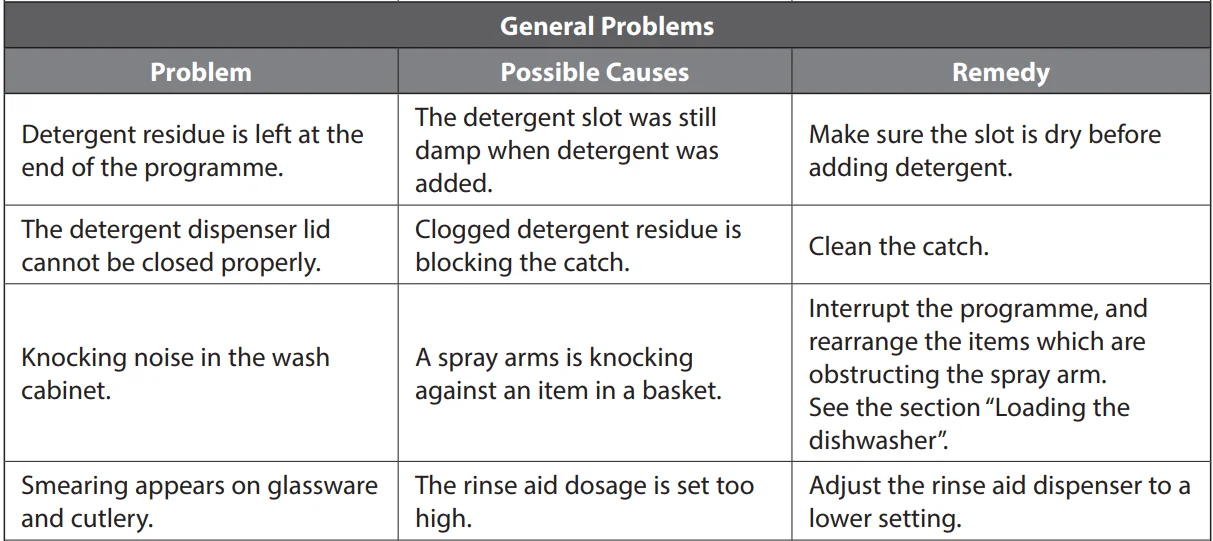
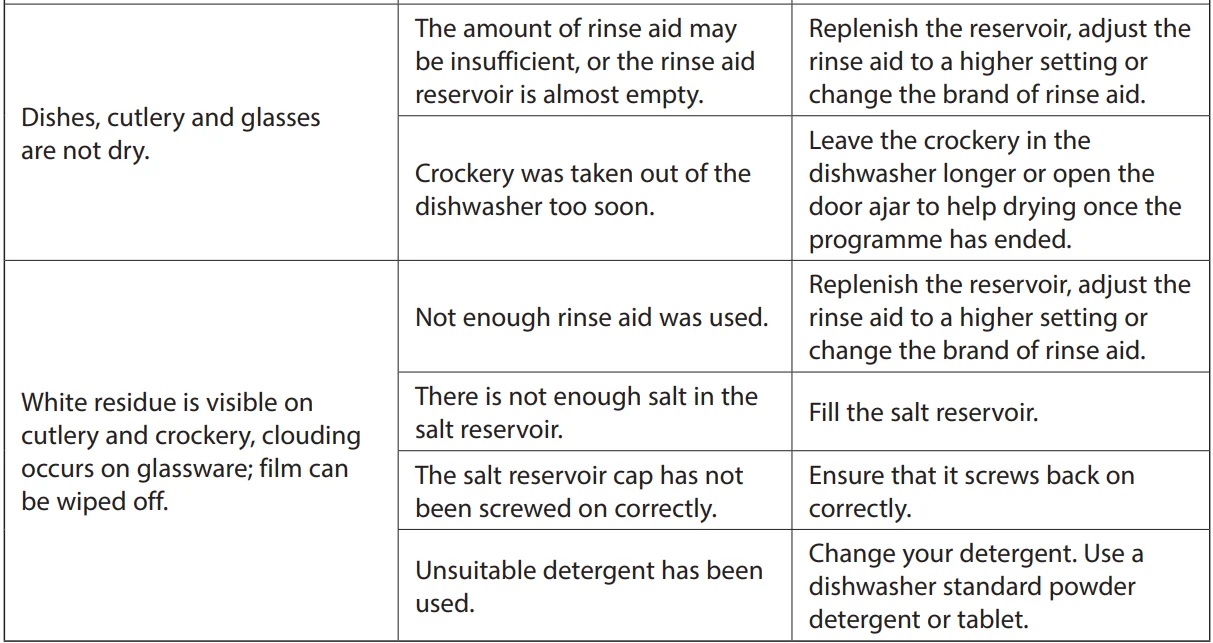
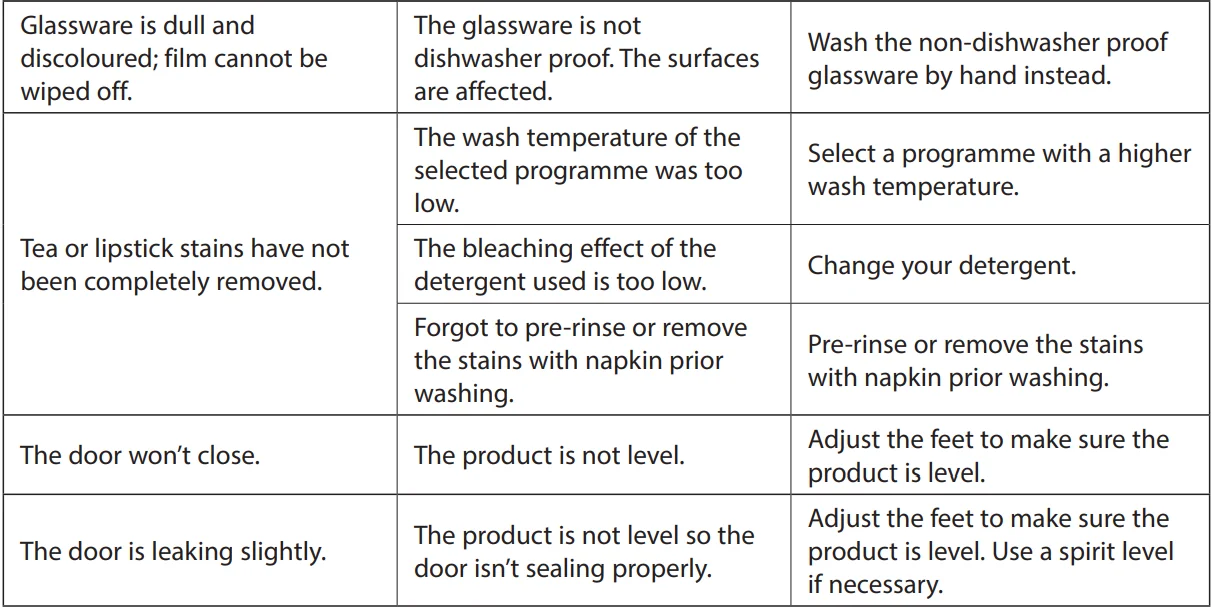
Disposal of the Dishwasher
- When disposing of your old dishwasher, first make it unusable. Disconnect from the electricity and water suppliers, cut off the cable and the plug from the cable. Make the door lock inoperable so that children cannot accidentally shut themselves in. Make appropriate arrangements for the disposal of the dishwasher.
- At the end of its working life, the product must not be disposed of as urban waste. It must be taken to a special local authority differentiated waste collection centre or to a dealer providing this service. Disposing of a household appliance separately avoids possible negative consequences for the environment and health deriving from an inappropriate disposal and enables the constituent materials to be recovered to obtain significant savings in energy and resources. As a reminder of the need to dispose of household appliances separately, the product is marked with a crossed-out wheeled dustbin.
- Please ensure that it presents no danger to children while being stored for disposal.
Disposal of Packing Material
Please dispose of the plastic wrappings and bags safely and keep them out of the reach of babies and young children.
Product Fiche and Specifications
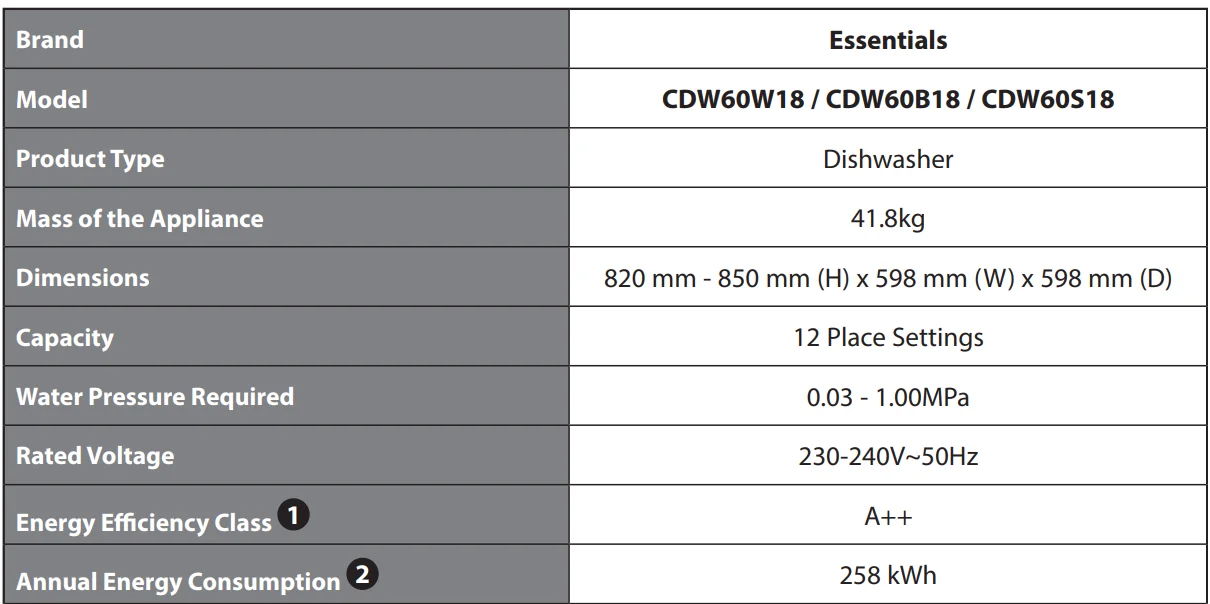
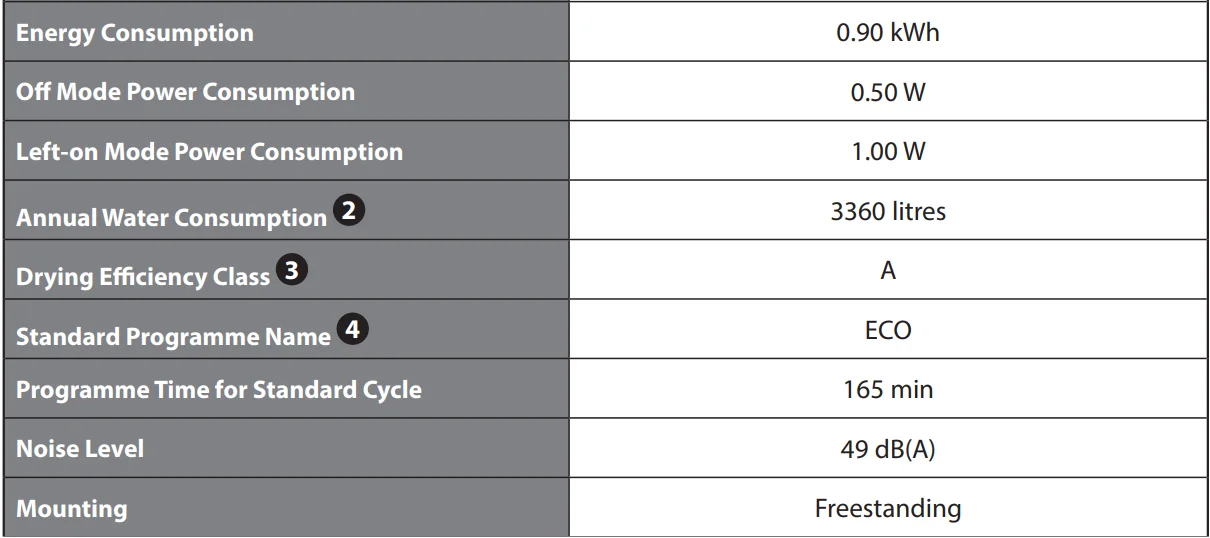
Features and specifications are subject to change without prior notice.
For more manuals by Currys, visit ManualsLibraryy
Currys ESSENTIALS CDW60W18 Full-Size Dishwasher- FAQs
How do I turn on my Currys Essentials dishwasher?
Close the door firmly, select your preferred program, then press the Start/Pause button to begin the cycle.
Why is my Currys Essentials dishwasher not draining?
A blocked drain filter, clogged drain pump, or kinked drain hose is usually the cause. Clean the filter and check the pump and hose for obstructions.
Why does my dishwasher stop mid-cycle with water inside?
This happens when the drain pump or filter is blocked. Remove debris, clean the filter, and ensure the drain hose is not obstructed.
How do I reset a Currys Essentials dishwasher?
Turn off the appliance, reconnect power, then press and hold the Start/Pause button for 3–5 seconds to reset the system.
What is the most common dishwasher fault?
The most frequent issue is poor drainage, often due to a clogged filter or blocked drain hose.
How do I reprogram the dishwasher control panel?
Press Cancel/Drain, unplug the appliance for one minute, reconnect power, then start a new cycle.
How do I reset a dishwasher that won’t drain?
Clean the filter, clear the drain area, inspect the hose, and then perform a power reset by unplugging the dishwasher for a few minutes.
Can I throw a dishwasher pod directly into the tub?
No. Pods should be placed in the detergent dispenser to dissolve at the correct time during the wash.

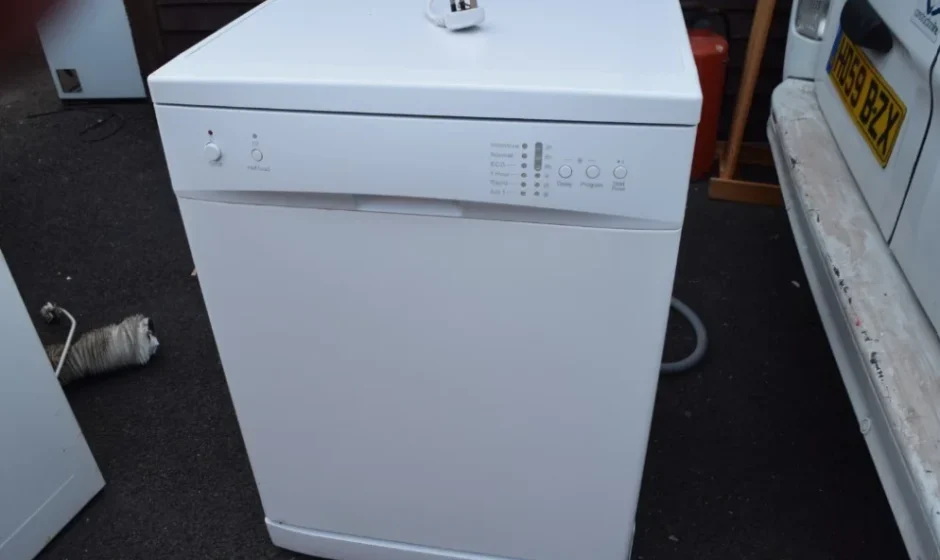
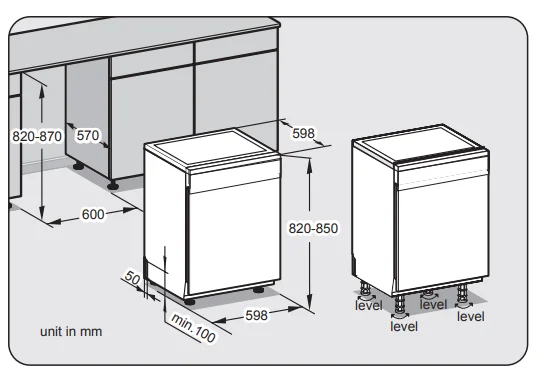
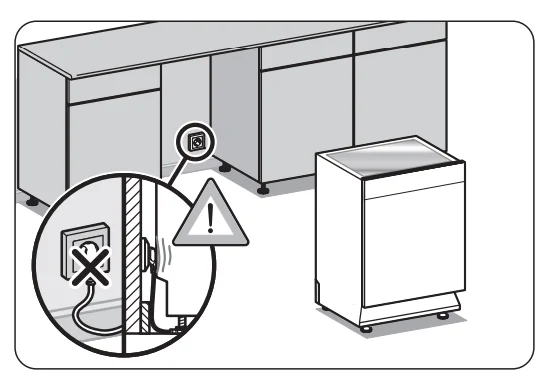

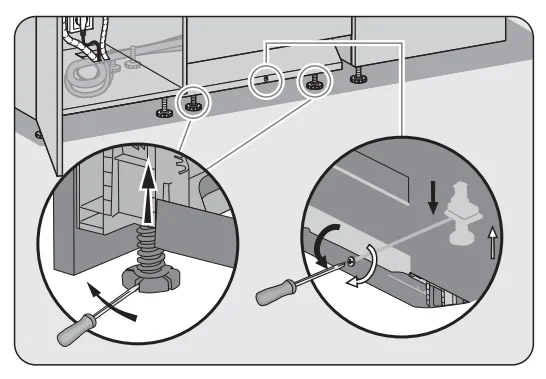 Making sure the dishwasher is level is very important. If it’s not level, the door may not seal properly, and it may leak.
Making sure the dishwasher is level is very important. If it’s not level, the door may not seal properly, and it may leak.